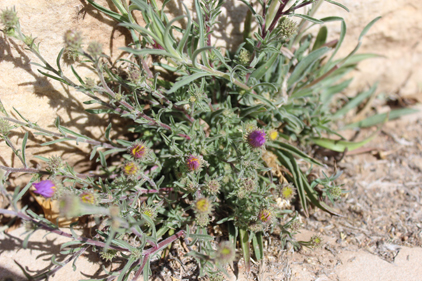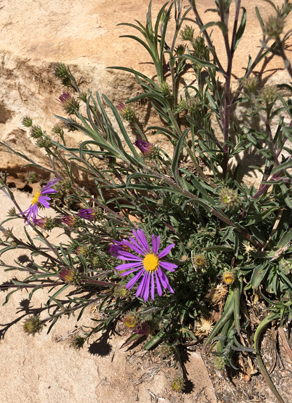 |
 |
The plant w/buds |
The plant w/flowers |
Description
"Duration: Biennial Nativity: Native Lifeform: Forb/Herb General: Annual, biennial, or short-lived perennial herbs, to 70 cm tall; stems branched; herbage glabrous, puberulent, or canescent, sometimes also stipitate-glandular or gland-dotted. Leaves: Alternate and usually sessile along the stems, leaf bases on some individuals tapering into petioles; blades linear-lanceolate, linear, or linear-oblanceolate, the mid-stem leaves 1-6 cm long and 1.5–6 mm wide; margins entire to irregularly dentate or serrate; faces glabrous, puberulent, or canescent, sometimes sparsely stipitate-glandular; bases of upper leaves sometimes clasping the stem. Flowers: Flower heads showy, radiate, purple with yellow centers, arranged in terminal panicles; involucres campanulate or turbinate, 6-10 mm high, the bracts (phyllaries) in 3-10 well-graduated series, the outer phyllaries much shorter than the inner; phyllary bases straw colored and firm (indurate) and phyllary tips green, herbaceous, usually appressed; phyllary faces glabrous or hairy on the green tip only, sometimes also stipitate-glandular; ray florets 10-25 per flower head, the laminae (ray petals) 6-12 mm long, white, blue, or purple; disc florets yellow. Fruits: Achenes appressed-pubescent or glabrous; topped with a pappus of bristles. Ecology: Found in open, often sandy sites, on flats and slopes, from 3,000-9,500 ft (914-2896 m); flowers July-October. Distribution: Western N. Amer. from British Columbia to Saskatchewan, south through WA, ID, MT and ND to CA, AZ, NM and TX; south to nw MEX. Notes: Look for this incredibly variable species under Aster canescens in older texts. There are many other synonyms as well, most notably Machaeranthera canescens. There have been a number of recent changes in what used to be the Aster genus, and species descriptions from different sources, even recent sources, are in conflict. This species description is roughly in line with the one in Flora of North America (2006), with edits based on which traits were actually visible and reliable on herbarium specimens at Northern Arizona University. There are 3 species in what is currently being called Dieteria: D. asteroides, D. canescens, and D. bigelovii. They are morphologically variable, challenging to distinguish from each other, and often intergrade so that differences described in the keys are not always helpful. D. asterides and D. canescens are the most similar; distinguish between them by looking at the phyllaries with your hand lens. The phyllaries on D. asteroides are hairy all over, on both the straw-colored bottom portion and the darker green tip, are more likely to have glandular hairs, and always have longer green tips, which are about as long as the light-colored portion and spreading so that they point outward or downward. D. canescens has less hairy phyllaries, which are often hairy on the green tip but usually not on the straw-colored base. The phyllaries on D. canescens are straw-colored for the lower two-thirds or more, with short green tips that do not spread away from the flower head or only spread a little. The third species, D. bigelovii, is easier to tell apart from the other two Dieteria spp. It has long narrow linear leaves with few, if any, shallow teeth or lobes, and larger flower heads, the largest flower heads on most plants having involucres about 2 cm or a little more in diameter (usually 1.5 cm or smaller involucres on D. asteroides and D. canescens.) D. bigelovii also has long-acuminate, reflexed (curved downward) phyllary tips, which are often tinged red or purple. Ethnobotany: Used medicinally to treat throat and nose troubles and headaches; also used as an emetic, an eyewash, a blood tonic, and a strong stimulant. Etymology: Dieteria comes from the Greek di, two, and etos, year, alluding to the biennial duration; canescens means covered in short, gray hairs. Synonyms: Machaeranthera canescens, Aster canescens, and many others." (SEINet)
Internet Resources